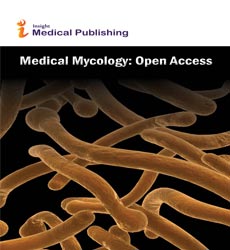Abstract
Study on Biofilms of T. rubrum and T. mentagrophytes with Antifungal Susceptibility Pattern and Detection of MBL in Patients with Chronic and First Episode Dermatophytosis in a Tertiary Care Centre in South India
Background: In India, there has been an increase in the prevalence of dermatophytosis of the glabrous skin associated with therapeutic non-response to conventional regimens and a need for prolonged duration of treatment, in the recent years. Antifungal resistance to some antifungal drugs has been observed. Biofilms produced by dermatophytes hinders the host immune response and poses difficulty in treatment. Deficiency of Mannose Binding Lectin (MBL) is known to predispose to susceptibility to infections.
Aim: To isolate dermatophytes from patients with first episode and chronic dermatophytosis and to explore the biofilm formation, and to observe their antifungal susceptibility profile; to determine the serum MBL levels and correlate with the Minimum Inhibition Concentration (MIC) values.
Methods: Phenotypic identification of the isolates done by conventional method was followed by Antifungal Susceptibility Testing (AFST) by broth microdilution method (CLSI M38-A2).
Biofilm formation assay was carried out by crystal violet staining method. ELISA based assay was performed for the samples using monoclonal antibody against the MBL carbohydrate- binding domain with reading taken at 620 nm.
Results and Conclusion
Among the 64 patients with chronic dermatophytosis and 36 with first episode, Trichophyton mentagrophytes was the most common isolate (58%) followed by T. rubrum (42%). Biofilm formation was stronger in T. rubrum (57.1%) than T. mentagrophytes (37.9%) (p<0.001). Strong biofilm was formed by 71.9% of dermatophytes causing chronic dermatophytosis as compared to none of those causing first episode, with statistical significance. Lowest MIC was seen with fenticonazole and luliconazole (0.06 μg/ml), while the highest MIC value (2 μg/ml-64 μg/ml) was for fluconazole. MBL levels were in the deficient range for both patients (0.5 ng/ml-40 ng/ml) and controls (0.048 ng/ml-0.107 ng/ml) with the higher values being observed among patients.
Author(s): Veena Hemanth1, Anupma J Kindo1*, Madhu R2, Anandan Sankarasubramaian3 and Adi Krishnan3
Abstract | Full-Text | PDF
Share this

Google scholar citation report
Citations : 164
Medical Mycology: Open Access received 164 citations as per google scholar report
Abstracted/Indexed in
- Google Scholar
- China National Knowledge Infrastructure (CNKI)
- Directory of Research Journal Indexing (DRJI)
- WorldCat
- Publons
- Geneva Foundation for Medical Education and Research
- Secret Search Engine Labs
Open Access Journals
- Aquaculture & Veterinary Science
- Chemistry & Chemical Sciences
- Clinical Sciences
- Engineering
- General Science
- Genetics & Molecular Biology
- Health Care & Nursing
- Immunology & Microbiology
- Materials Science
- Mathematics & Physics
- Medical Sciences
- Neurology & Psychiatry
- Oncology & Cancer Science
- Pharmaceutical Sciences
